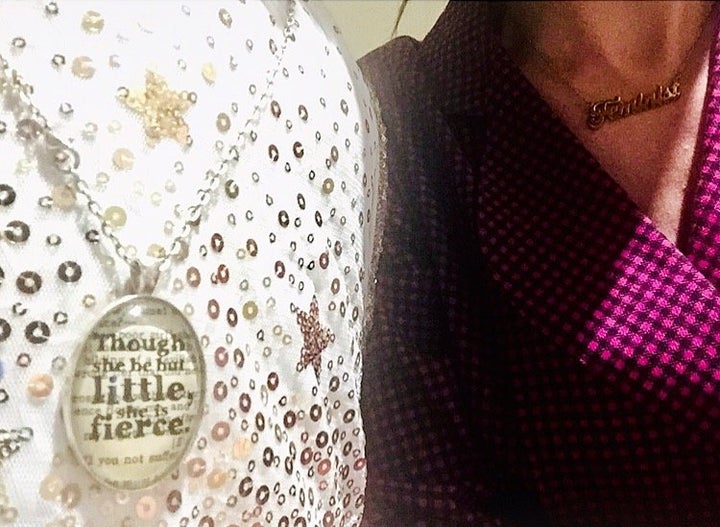On my daughter’s fifth birthday I gave her a necklace that said: “Though she be but little, she is fierce”. The quote comes from Shakespeare’s A Midsummer Night’s Dream – and I couldn’t have found a more inspirational message.
When we’re out together, I wear a necklace of my own that says, simply, ‘Feminist’. It’s a clear message to the world, and to my children, that feminism matters. I am determined to raise my daughter as one – and my son, too, because I can’t imagine anything more important than teaching them to fight for equality. Particularly when we live in a world which is anything but.
From the UK’s growing gender pay gap, to statistics showing 20% of women have experienced some type of sexual assault since the age of 16, to the existence of FGM and pregnancy-related discrimination– it’s clear we’ve got a long, long way to go before we win this particular battle of the sexes.

And even when research shows that gender stereotyping can cause significant harm in later life, it’s still virtually impossible to get away from throwaway comments such as “boys will be boys”, while girls are told that showing drive and determination is “bossy”.
It can sometimes feel like you’re banging your head against a brick wall when you notice gender norms being consistently reinforced in daily life – such as walking into your child’s nursery to see someone handing a little girl a doll to play with, and a little boy a truck or car.
So, what do you do if you want to raise your kids as equals, and to treat others in exactly the same way? Here are six ideas to help kids of either gender, or none, identify as feminists.
1. Find Out What It Means
Some people are confused by the definition of feminism – believing, wrongly, that it means tipping the balance to make those who identify as women stronger or more successful than men. But feminists want political, economic, personal, and social equality of the sexes. Ergo, feminism IS equality.
I have a simple phrase I use all the time with my kids if I hear the dreaded phrase, “only boys can...” or “only girls can...”. “That’s wrong,” I say. “Boys and girls are the same. They can do the same things.” My proudest moment? Seeing my daughter set a bunch of older kids straight in the local playground with exactly this phrase. In fact, she went one better with her brother, coining the wisdom, “everyone has bums” – which is as gender inclusive as it comes.
2. Read To Them
A simple way to change how your kids view gender is by reading books with them that challenge lazy norms or stereotypes, recent research shows. Here is a list of six groundbreaking titles you could try. My daughter’s favourite is the ‘Goodnight Stories for Rebel Girls’ series – we read about an inspirational woman every single night.
3. Talk About It
Clinical psychologist Dr Helen McCarthy told me kids love being included in discussions where their point of view is listened to respectfully. Sitting down together for a family dinner can be a great time to unpick any sexist comments they may have heard at school. “Don’t panic if your child seems to hold a view that you don’t agree with,” Dr McCarthy said. “You can say you don’t agree and why – and this can help them shape their own view.”

4. Watch What They Watch
Sometimes the most seemingly innocent TV programmes can unwittingly reinforce gender norms you may not be happy with: like Peppa Pig with its subtle, but insidious gender stereotyping. Boys “aren’t allowed” in Peppa’s treehouse, and Daddy Pig and George express disgust when Daddy Pig’s football shirt is accidentally dyed pink. Bad form, piggy pals.
[Read More: Why Peppa Pig Is A Terrible Role Model for Kids]
5. Let Them Wear Pink
Don’t limit their choices – as long as they’re their choices. My daughter loved pink, and for a while, would only wear dresses. She’s coming out of that now, mainly because she loves rock climbing (and you can’t climb properly dressed as a princess), but I was mindful not to dictate what she wanted to wear, because feminism is also about choice. Never have I seen an expression of purer joy than the look on my two-year-old son’s face when he got to wear his sister’s gold sequin pom-pom skirt to the park.
6. Give Them Options
Tell the people who love your children that you’re committed to not stereotyping your kids – and steer them towards gender-equal or gender-neutral gift-giving. For every doll your little girl is given, ask people to consider getting trucks and cars, too. For every tool kit bought for your son, get the ingredients to go in a toy kitchen. Provide a range of options and they’ll soon decide for themselves.